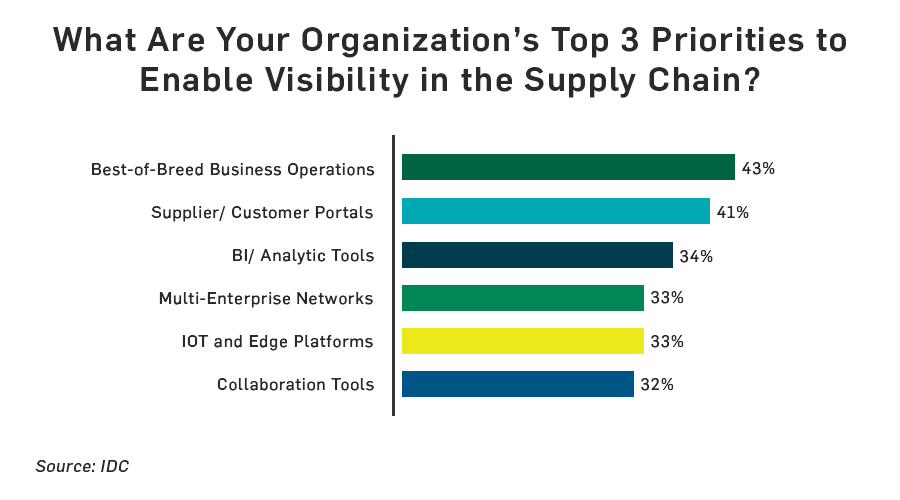Table of contents
Key Takeaways
-
IDC's formula for achieving supply chain resiliency is: Visibility + Agility + Responsiveness = Resiliency
- You can increase supply chain visibility by embracing a multi-enterprise business network and sharing more diverse data sets with upstream and downstream partners.
- More than three quarters of pharma supply chain companies believe that increased visibility will lead to a reduction in drug shortages.
The goal of achieving actionable, end-to-end pharma supply chain visibility should be at the core of your supply chain transformation plans, according to new industry research from IDC. That’s because without visibility, you can’t have agility, you can’t have resiliency, and you’ll most likely be ill-prepared to respond to major supply chain disruptions like those caused by COVID-19.
Companies have made a minor amount of progress, but visibility is still very patchy in my experience. I think the idea of universal visibility in the supply chain is still in its infancy and there is a long way to go. — Senior Pharma Supply Chain Executive
But what capabilities do you need to develop to achieve greater visibility—and how do you get there? It begins with adopting a holistic, outside-in supply chain management strategy, embracing a three-stage transformation plan, and investing in the people, processes, technology, and leadership needed to ensure proper execution.
IDC and TraceLink surveyed more than 500 companies, including manufacturers, distributors, logistics providers, and retail pharmacies, and health systems, to explore the impact of COVID-19 on the pharmaceutical and identify what it will take to achieve greater supply chain visibility, agility, and resilience in the future. The survey findings, which can be found in the new IDC white paper, “Supply Chain Agility in the Pharmaceutical Industry,” were augmented with details from in-depth interviews with three pharma supply chain executives.
How are pharma manufacturers addressing the supply chain visibility problem today?
Across the end-to-end supply chain, pharmaceutical manufacturers are the most likely to view visibility as one of their most significant supply chain gaps that need to be addressed, according to IDC. The survey results also show that pharma companies clearly understand that technology is an important enabler of visibility.
The chart below shows the top areas pharmaceutical manufacturers are focusing on to improve visibility. Improving legacy systems such as supply chain business applications and customer or supplier portals is a top priority, demonstrating the industry’s relative immaturity when it comes to achieving end-to-end visibility.

While a handful of pharma companies have successfully pursued greater supply chain visibility and agility, most have not prioritized the capabilities systematically and efforts to improve visibility remain more aspirational than achieved. This lack of visibility has resulted in the degradation of key metrics like product availability and OTIF performance, according to IDC.
5 capabilities for achieving end-to-end, actionable visibility
The ongoing COVID-19 pandemic underscores the fact that massive disruptions are inevitable in the pharma supply chain. Companies that have yet to begin the systematic process of improving actionable visibility should begin doing so now, or they’ll risk being unprepared when the next wave of disruptions threatens the flow of life-saving medicines to patients.
50% of pharma supply chain companies lack the visibility needed to effectively react to marketplace changes. 78% believe better visibility would enable them to significantly reduce drug shortages. — IDC
Improving visibility will likely require your organization to advance the way it uses technology—e.g., making better use of shared data, processes, and analytics—and set new expectations around using different and better metrics for analyzing patient-demand and the performance of upstream and downstream partners.
Based on the research study’s findings, IDC identified five key steps pharma supply chain companies can take to develop the capabilities required to improve visibility. These include:
- Take advantage of multi-enterprise business networks
Using multi-enterprise business networks to exchange information and better collaborate with downstream and upstream trading partners delivers real-time visibility that will ultimately lead to greater supply chain agility.
- Leverage more diverse data sets
Collect demand data from various downstream sources to aggregate realistic and reasonable data and improve demand forecasts for use in planning the product supply network.
- Take a holistic approach to data analytics
A multi-enterprise business network and advanced analytics is a powerful combination that enables your organization to find and answer questions that could not be addressed with interconnected transactional architectures of systems and idata investments of the past.
- Learn to collaborate better within relevant ecosystems
In addition to leveraging a multi-enterprise network, look for quick wins by adopting technology that brings collaboration and responsiveness to existing systems and processes to improve overall visibility and agility.
- Capitalize on the Internet of Things (IoT)
IoT is about more than just sensors—it’s about developing a continuous stream of real-time data about product demand and product movement through the supply chain. In other words, IoT presents an opportunity for vastly improved actionable data and analytics.
While some progress is being made, the overall state of visibility in the pharmaceutical industry is quite limited and tends to be achieved with standalone event-driven systems like control towers.
Download the IDC white paper “Supply Chain Agility in the Pharmaceutical Industry” to learn more.



